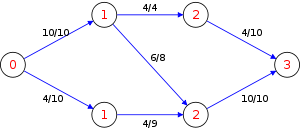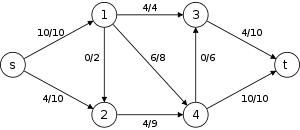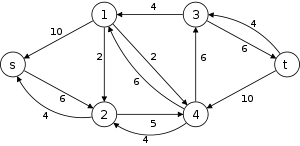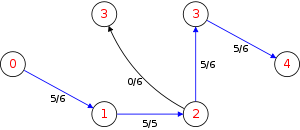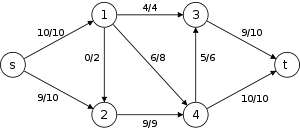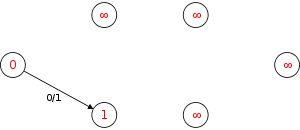- Dinic's algorithm
-
Dinic's algorithm is a strongly polynomial algorithm for computing the maximum flow in a flow network, conceived in 1970 by Israeli (formerly Soviet) computer scientist Yefim Dinitz. The algorithm runs in O(V2E) time and is similar to the Edmonds–Karp algorithm, which runs in O(VE2) time, in that it uses shortest augmenting paths. The introduction of the concepts of the level graph and blocking flow enable Dinic's algorithm to achieve its performance.
Contents
Definition
Let G = ((V,E),c,s,t) be a network with c(u,v) and f(u,v) the capacity and the flow of the edge (u,v) respectively.
- The residual capacity is a mapping
 defined as,
defined as,
- if
 ,
,
- cf(u,v) = c(u,v) − f(u,v)
- cf(v,u) = f(u,v)
- cf(u,v) = 0 otherwise.
- if
- The residual graph is the graph
 , where
, where
 .
.
- An augmenting path is an s − t path in the residual graph Gf.
- Define
 to be the length of the shortest path from s to v in Gf. Then the level graph of Gf is the graph
to be the length of the shortest path from s to v in Gf. Then the level graph of Gf is the graph  , where
, where
 .
.
- A blocking flow is an s − t flow f such that the graph G' = (V,EL',s,t) with
 contains no s − t path.
contains no s − t path.
Algorithm
Dinic's Algorithm
- Input: A network G = ((V,E),c,s,t).
- Output: An s − t flow f of maximum value.
- Set f(e) = 0 for each
 .
. - Construct GL from Gf of G. If
 , stop and output f.
, stop and output f. - Find a blocking flow
 in GL.
in GL. - Augment flow
 by
by  and go back to step 2.
and go back to step 2.
Analysis
It can be shown that the number of edges in each blocking flow increases by at least 1 each time and thus there are at most n − 1 blocking flows in the algorithm, where n is the number of vertices in the network. The level graph GL can be constructed by Breadth-first search in O(E) time and a blocking flow in each level graph can be found in O(VE) time. Hence, the running time of Dinic's algorithm is O(V2E).
Using a data structure called dynamic trees, the running time of finding a blocking flow in each phase can be reduced to O(Elog V) and therefore the running time of Dinic's algorithm can be improved to O(VElog V).
Special cases
In networks with unit capacities, a much stronger time bound holds. Each blocking flow can be found in O(E) time, and it can be shown that the number of phases does not exceed
 and O(V2 / 3). Thus the algorithm runs in O(min(V2 / 3,E1 / 2)E) time.
and O(V2 / 3). Thus the algorithm runs in O(min(V2 / 3,E1 / 2)E) time.In networks arising during the solution of bipartite matching problem, the number of phases is bounded by
 , therefore leading to the
, therefore leading to the  time bound. The resulting algorithm is also known as Hopcroft–Karp algorithm. More generally, this bound holds for any unit network — a network in which each vertex, except for source and sink, either has a single entering edge of capacity one, or a single outgoing edge or capacity one, and all other capacities are arbitrary integers.[1]
time bound. The resulting algorithm is also known as Hopcroft–Karp algorithm. More generally, this bound holds for any unit network — a network in which each vertex, except for source and sink, either has a single entering edge of capacity one, or a single outgoing edge or capacity one, and all other capacities are arbitrary integers.[1]Example
The following is a simulation of the Dinic's algorithm. In the level graph GL, the vertices with labels in red are the values
 . The paths in blue form a blocking flow.
. The paths in blue form a blocking flow.History
Dinic's algorithm was published in 1970 by former Russian Computer Scientist Yefim (Chaim) A. Dinitz , who is today a member of the Computer Science department at Ben-Gurion University of the Negev (Israel), earlier than the Edmonds–Karp algorithm, which was published in 1972 but was discovered earlier. They independently showed that in the Ford–Fulkerson algorithm, if each augmenting path is the shortest one, the length of the augmenting paths is non-decreasing.
See also
- Ford–Fulkerson algorithm
- Maximum flow problem
Notes
- ^ Tarjan 1983, p. 102.
References
- Yefim Dinitz (2006). "Dinitz' Algorithm: The Original Version and Even's Version". In Oded Goldreich, Arnold L. Rosenberg, and Alan L. Selman. Theoretical Computer Science: Essays in Memory of Shimon Even. Springer. pp. 218–240. ISBN 978-3540328803. http://www.cs.bgu.ac.il/~dinitz/Papers/Dinitz_alg.pdf.
- Tarjan, R. E. (1983). Data structures and network algorithms.
- B. H. Korte, Jens Vygen (2008). "8.4 Blocking Flows and Fujishige's Algorithm". Combinatorial Optimization: Theory and Algorithms (Algorithms and Combinatorics, 21). Springer Berlin Heidelberg. pp. 174–176. ISBN 978-3-540-71844-4.
Categories:- Network flow
- Graph algorithms
- The residual capacity is a mapping
Wikimedia Foundation. 2010.



